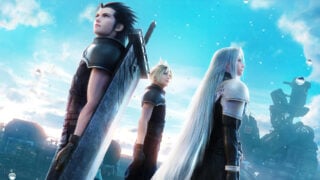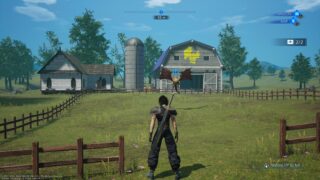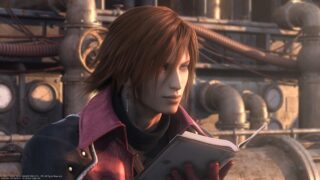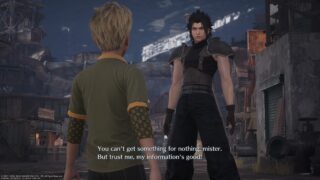Crisis Core: Final Fantasy VII Reunion has plenty to offer as a remaster
Square Enix’s PSP remaster is sharp and slick, yet feels a little fragmented as a console game
- Creative director
- Tetsuya Nomura
- Key Credits
- Kazushige Nojima (Scenario), Takeharu Ishimoto (Music)

As remasters go, Crisis Core: Final Fantasy VII Reunion is one of the more carefully considered examples. To make a title originally built for the PSP feel at home on current generation machines, Square Enix hasn’t merely given it a HD facelift; it’s significantly updated visuals, audio and even a few game mechanics.
The result is a kind of halfway house between the flashy production values of Final Fantasy VII Remake, and the compact ambitions of the 2007 game. For the most part, that makes for an agreeable compromise, although some remnants of the original translate better than others in the jump from handheld play.
For the uninitiated, Crisis Core acts as a prequel to Final Fantasy VII, following the adventures of Zack Fair, a character who only featured briefly in flashback in the main game. As a member of Shinra Corp’s elite military unit, SOLDIER, Zack’s fortunes intertwine with those of Cloud and Sephiroth, the hero and villain to come.
Yet Crisis Core is more of an action game with light RPG elements than a full-blown RPG, with Zack charging into battle alone to hack away at monsters and evildoers with his oversized sword.
Reunion doesn’t change any of that, but first impressions certainly disguise that this was once a PSP game. The main character models, for instance, have been replaced with fresh ones that could pass for their Remake counterparts if you squint, and you’ll notice that menus and tutorial tips have the same stylings as the 2020 game.
Combat has also been spruced up and immediately feels much more dynamic. The camera holds closer to the action and is now fully controllable, while Zack shifts around as if he’s been charged with extra power himself, his blade combos landing with zest and ferocity.
There are tweaks to the systems too. The bread and butter of Zack’s fighting style is a responsive pattern of dodge-slice-repeat, but with zero fuss you can trigger any of six equipped materia – from spells such as fire or cure, to deadly special techniques – by holding L1 and tapping the assigned face or right shoulder button.
Another smart new touch comes into play when larger enemies prepare to unleash their most devastating attacks. Where before you had to take the blow, now you can damage your opponent while they’re charging up to reduce the power of their assault or cancel it completely.
Underpinning these new flourishes is a bedrock of customisation options, which enable you to outfit Zack in myriad ways. Deciding which materia to carry into battle from the many you collect over the course of the game, along with which accessories to equip, can make all the difference when coming up against stubborn bosses.
Or if you feel underpowered, perhaps it’s time to fuse some materia together to create higher level versions and new alternatives. Either way, there’s plenty to play with, and the repurposing of the materia system from turn-based party battles to fast-paced action remains one of Crisis Core’s great successes.
“The main character models have been replaced with fresh ones that could pass for their Remake counterparts if you squint, and you’ll notice that menus and tutorial tips have the same stylings as the 2020 game.”
And yet, only occasionally do you really need to strategize, since the majority of fights are over almost before they’ve started. Dodging and slicing will see you to victory more often than not, especially since many enemies telegraph attacks, giving you time to circle around and chip away as they fail to keep up.
Some have a little more nous, but it hardly matters when you meet the same types time and again and learn which spells and techniques destroy them most proficiently. Indeed, according to the story, some of the enemies are literally clones. “Too many copies,” Zack comments at one point. Quite.
The repetition in combat is especially apparent when it comes to side missions, of which there are a couple of hundred or so. They are at least convenient, in that you can dip in and out of them instantly from any save point, even when you’re in the middle of a chapter, to boost your level and equipment. But each one merely contains a few battles against monsters you’ve already fought, and wading through more than three or four in a row is a dull process.

It’s here that the limitations of a remaster, even a good one, become apparent. Because, of course, beneath all the improvements, Reunion is still a game that was tailored to the PSP. So while these missions were once ideal for brief sessions, where you might knock off a handful between other engagements, a more focused session in front of a console exposes them as a largely mindless grind.
The game’s locations are similarly affected by the shift, in that Crisis Core squashes and slices the world of Final Fantasy VII into handy bite-sized pieces that feel scrawny when magnified on a big screen.
Main missions are a stop-start affair, with very light exploration around tiny maps, and mostly pointless distractions outside combat that fail to create much sense of place (one sequence where you track down a child who’s stolen your wallet is interminably tiresome). The metropolis that is Midgar, meanwhile, which you return to between missions, is reduced to a handful of sparsely populated streets.
Unfortunately, the remaster hasn’t managed to do anything about the quality of the English script, either, which was never Crisis Core’s strong point and is largely unaltered here. There are still conversations that barely make sense, as if you’d skipped a line between responses, and some extremely clumsy phrasing.
“Reunion is still a game that was tailored to the PSP. So while these missions were once ideal for brief sessions… a more focused session in front of a console exposes them as a largely mindless grind.”
Square Enix has gone to the trouble of re-recording lines with new actors, including some of the cast of Remake, but it matters little when they’re hamstrung by the old dialogue and speech patterns that have to fit the original animations.
Finally, and perhaps contentiously, we’re still not convinced that the narrative in Crisis Core really adds much of value to Final Fantasy VII as a story. It doesn’t help that Zack is an annoyingly cocky protagonist without much depth in his motivations.
But also, the retrofitted plot, which dovetails with the flashback scenes in the main game, does little to make characters such as Aerith and Sephiroth more interesting, while the addition of fellow elite SOLDIERs Genesis and Angeal only convolutes the tale already told. “No story is not worth hearing,” Angeal says. Maybe. But perhaps some stories didn’t need telling.
Then again, we’ll take any excuse to return to Midgar and its surrounding regions, because they’re so rich in artistic design and lore. And whether you’re fiddling with materia setups, reliving iconic moments from an alternate perspective, or soaking in the superb music, Reunion should hold the attention. Plus the quality of the remastering isn’t to be sniffed at, adding flavour to a decent snack between larger helpings of Final Fantasy VII.
Crisis Core Reunion has plenty to offer as a remaster, with improved visuals and tighter combat than the PSP original. The fragmented structure of the game, however, remains more suited to a handheld machine, and a poor English script is sadly unchanged. If you’re hankering for more Final Fantasy VII, though, it’s well worth diving in.
- Extensive audio and visual improvements
- Slick and responsive combat
- The materia system is still deep and interesting
- Side missions are highly repetitive
- Dull locations and non-combat activities
- The script doesn’t do the characters justice

























